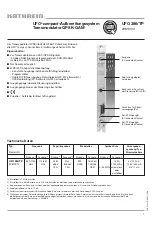
SDM-2020 Satellite Demodulator
Data Interfaces
Rev.3
A–29
Table A-15. Terrestrial Transport Protocols
Data Valid
For all TX framing modes, the data valid input “DVALID” will be ignored. Packet structures
and validity of data will be based on the programmed frame format.
For all RX framing modes, the data valid output “DVALID” will operate as defined in the
frame mode definitions.
Transmit Interface
Synchronization Modes
The transmit interface supports two synchronization modes:
1.
Sync Byte Data Correlation Mode - Frame synchronization is correlated from the
packet input data, based on the embedded sync word (47 HEX). In this mode the
“SYNC” input is ignored.
2.
External Sync Mode - Frame synchronization is based on the external “SYNC” input.
In this mode the data which occupies the sync byte data position(s) is over written with
a valid sync word (47 HEX) based on the occurrence of the “SYNC” input timing by
the Modem.
Notes:
1.
The frame synchronization mode is not directly selectable by the user from the front
panel interface.
2.
Refer to the SDM-2020 Modulator for synchronization mode.
Serial Data Formats
The processing order shall always start from the MSB (i.e. “0”) of the sync word-byte (i.e.,
01000111).
187 Byte (no framing) Serial
Format
The 187 byte format contains no framing information. Figure A-7 shows the general packet
arrangement from the receiver. There is no sync, so the “SYNC” signal is always logic “0”.
Since data is always present, the data valid signal “DVALID” is always logic “1”. The SYNC
and DVALID signals into the transmitter are not utilized
188 Byte Serial Format
The 188 byte serial format consists of 1 sync byte (8 bits, MSB first), followed by 187 payload
bytes (1496 bits). Figure A-8 shows the signal relationships for the 188 byte serial interface.
The DVALID signal into the transmitter is not utilized.
204 Byte Serial Format
The 204 byte serial format consists of 1 sync byte (8 bits, MSB first), 187 payload bytes (1496
bits), and 16 dummy bytes (128 bits for Reed-Solomon check-sum). Typically the 16 dummy
bytes reserved for Reed-Solomon coding are set to zero (logic low), this is a requirement at
the receive interface. Figure A-9 shows the signal relationships for the 204 byte serial format.
Note that the “DVALID” signal is de-asserted during the last 16 bytes of the frame. The
DVALID signal into the transmitter is not utilized.
204 Byte DBS Serial Format
A special case of the 204 byte format is the Digital Broadcast via Satellite (DBS) mode. The
DBS mode is the same as the general 204 byte format except that the sync pulse is only
asserted during the first bit of the sync byte. Figure A-10 shows the signal relationships for the
204 byte DBS serial format. The DVALID signal into the transmitter is not utilized.
Summary of Contents for SDM-2020
Page 32: ...SDM 2020 Satellite Demodulator Introduction Rev 3 1 17 This page is intentionally left blank...
Page 35: ...SDM 2020 Satellite Demodulator Installation Rev 3 2 3 Figure 2 1 Typical Rack Installation...
Page 57: ...SDM 2020 Satellite Demodulator Operation Rev 3 3 13 This page is intentionally left blank...
Page 65: ...SDM 2020 Satellite Demodulator Operation Rev 3 3 21 This page is intentionally left blank...
Page 72: ...Operation SDM 2020 Satellite Demodulator 3 28 Rev 3 This page is intentionally left blank...
Page 75: ...SDM 2020 Satellite Demodulator Operation Rev 3 3 31 This page is intentionally left blank...
Page 92: ...Operation SDM 2020 Satellite Demodulator 3 48 Rev 3 This page is intentionally left blank...
Page 209: ...Fast Option SDM 2020 Satellite Demodulator C 6 Rev 3 This page is intentionally left blank...
Page 212: ...SDM 2020 Satellite Demodulator Glossary Rev 2 g 3 W Watt...
Page 213: ...Glossary SDM 2020 Satellite Demodulator g 4 Rev 3 This page is intentionally left blank...
















































